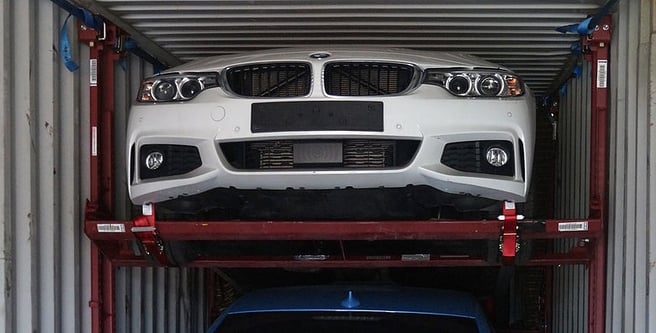
A car racking system is a helpful way of increasing the number of cars you can transport in a shipping container. Do it right and you can expand the capacity of a standard 40 or 45 foot container from 2 to 4 or even 6 cars. There is also less risk, as a containerised car is secure and doesn’t need to be handled multiple times before its end destination.
Do it wrong however, and you actually increase the risk of damage to your vehicles. In this article we explain the biggest mistakes that transport companies make with car racking systems, and why you should avoid them!
Why Use Containerised Shipping For Cars?
Let’s pause for a moment and consider why a business might use containerised shipping at all when transporting cars, rather than roll on, roll off (Ro-Ro) transportation? Ro-Ro is a time tested and reliable method of car logistics, with an established network of ports, shipping lanes and transfer networks in place. However, a journey from manufacturer to dealership can involve a lot of manual handling, with the car having to be physically driven on and off ship, then on and off a transportation lorry etc. Every time a car is handled there is a risk that it will be bumped or scratched. The more transfers involved in a journey, the higher your risk will be. Another danger that cars face during Ro-Ro transport is theft, often from insecure storage areas while cars are waiting to embark ship.
Containerised shipping eliminates both these issues with one stroke. Once a car is safely inside its shipping container, it doesn’t need to be moved until it reaches its final destination. The vehicle is also a lot more secure inside a shipping container than it is strapped to the deck of a ship. Nobody really knows what’s inside a shipping container when it has been sealed. The problem with shipping container transport for cars is the cost. If you can only store a couple of vehicles in each container, it can work out very expensive. Hence the popularity of racking solutions to increase the carrying capacity of a container. If a logistics business can get this right, then not only will container transport reduce vehicle handling requirements and the risk of stock damage, but it will also reduce your transportation costs.
The Problem With Car Racking…
Now we come to the big mistake that so many businesses make with car racking for containers: the racking itself simply isn’t very durable or sustainable. Most companies that use racking fabricate wooden structures that are installed within the container on site. Often known as ‘wood and string’ constructions, these often are literally created from wooden beams and rope.
There are several problems associated with this kind of racking:
- Unsafe transportation: Wooden car racking is only as good as the people who construct it. Unfortunately, due consideration is not always given to the weight of the car and the sustained pressure on the racking over time. It is not uncommon for car racking to collapse during the sea journey, or while the shipping container is being moved by crane. In shipping container transport for cars, structural collapse can cause massive damage to the vehicles inside. Even more common is minor damage to vehicles caused by splinters and vibrations.
- Inefficient use of space: A lot of wooden car racking systems are bulky and do not make efficient use of the space available in the container. Where a custom engineered racking system might increase capacity to 6 cars, a wooden racking system may only allow you to transport one additional vehicle – a lot of expense for very little gain.
- Labour-intensive: Wooden car racking systems take a big team to install them in each shipping container, then it is a lengthy process to install the cars, and taking the structure apart at the end is also time-consuming. All this adds up to a lot of time, all of which costs you money in wages.
- Wasteful of resources: What do you do with a wooden container racking system when it reaches its end point? Once taken down, most racking systems are too bulky for them to be worth shipping back to their starting point. So the wood is recycled, in some cases, resold or, most commonly, simply burnt. This is hugely wasteful of the material resources expended in creating the racking, and is also damaging to the environment.
Advanced Containerised Car Racking Systems From Trans Rak
With advances in reusable car racking technology, these horror stories are thankfully almost a thing of the past. Reusable steel racking allows you to transport multiple cars within a single container, even accommodating various cars of different types. It makes containerised shipping far more affordable, as well as reducing 90% of the handling involved in Ro-Ro shipping. To find out more about the benefits of containerised car transport, download our free Containerised Car Transport Guide, which can be accessed by clicking here.














